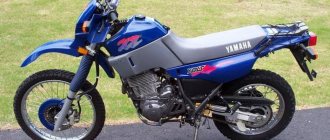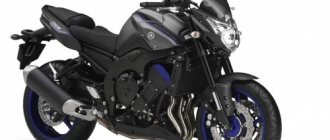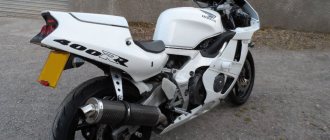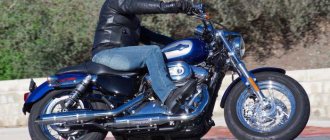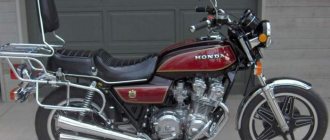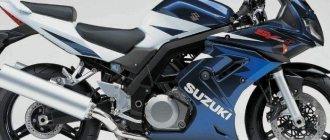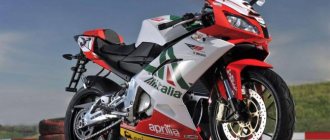Bike features
Here are the characteristic features of the Yamaha FZ1 (FZS 1000):
- This is the flagship model of the line;
- the motor was borrowed from the YZF-R1;
- The acceleration dynamics will impress many.
This motorcycle is convenient for daily use, because the seating position is relaxed. However, this is not so much an advantage of a particular model as a property of the class as a whole. Typically, sports motorcycles suffer from problems with ride comfort. But it’s worth considering that this bike may not be very convenient when riding with a passenger due to its not very large dimensions.
Yamaha FZ1000 2006
Much water has flowed under that proverbial bridge in the half decade since Yamaha FZ1 was introduced, and the world has changed markedly since then. When that groundbreaking 2001 model was released, company officials subsequently admitted they had doubts that enough of their customers would be interested in the bike. Fortunately, history has shown again (as it did with the FJR1300) that if you make a quality bike that's fun to ride and reasonably priced, buyers will come.
However, over time, some owners, along with respondents to consumer groups, began to voice requests for upgrades such as an aluminum frame, more power, better brakes and a more sophisticated suspension. Yamaha has responded to these requests by taking the FZ1 a whole step closer to the realm of sportbikes, while retaining the old-style charm that customers have come to love.
To address the most common complaints that the FZ 1000 was too inferior when compared to the YZF-R1 powerplant on which it was based, the company's engineers started with the newer and more powerful R1 engine, which had already been in use for three years. years. The FZ1 now shares the engine body and cylinder head shape with the 2005 R1, although the compression ratio has dropped slightly to 11.5:1. The fuel intake cams were raised higher than before, which helped the engine “breathe,” and in addition, engineers abandoned the use of small carburetors and used fuel injection. With the new injection, the engine starts instantly, regardless of whether it is warm or cold outside. And the idle control lever, which I had to fiddle with before, is now gone forever. When starting for the first time in the morning, except for idling at high speeds, nothing indicates that the engine is cold. After some time, the idle speed decreases, the coolant temperature returns to normal, and the motorcycle is ready to ride. To handle the extra power, a second thermostat-controlled fan is also added.
When riding towards you, the FZ1 looks like a typical sports bike
The engine of the Yamaha FZ1 is very flexible. You can cruise slowly through traffic in first gear without accelerating, and slow down to 30 mph (48 km/h) if you see a traffic cop nearby. And at the same time, the motorcycle revs up with pleasure and produces the best power without fear of the rev limit. There is a trade-off here, however, and that is low-end torque. Starting from a stop requires a little more clutch work than before, and this helps to gain more revs by moving the clutch further than when starting out. Power begins to increase more rapidly as you move past 4,000 rpm, and as you approach five thousand, the bike begins to strive for a top speed of 12,000 rpm. The ride characteristics of the motorcycle are excellent, just change to one or two gears, and those copushes next to you instantly become dots in your mirrors. At any reasonable speed (and some irrational speeds) the engine remains smooth with little noise from the four cylinders. Thick rubber-coated footpegs and rubber insulation on the footpegs and handlebars ensure that the rider experiences very little vibration.
We tested our 2006 model on the Dynojet dyno and compared the results to our previous data on the latest generation FZ1. Actual power increased by six horses, to 131 hp. This can be felt in the rapid movement - the motorcycle was already quite powerful, but now it evokes real admiration. Peak power now arrives at 11,500 rpm instead of 9,750 as before, but it does so with R1-like ferocity. The torque curve is quite smooth and even. However, torque is down 4 lb-ft, from last year's 72.2 lb-ft peak at 7,500 rpm to 68.0 at 9,250 rpm.
The six-speed transmission uses the same fluid coupling as the R1. The clutch lever uses a cable actuation system with little influence in high gears, but the modulation remains excellent and it handles unwanted slip or vibration well. But a hydraulic clutch is more suitable for traffic jams and when driving on mountain roads. Gear ratios better match the character of the engine. Closely spaced gear ratios allow the rider to quickly change gears around town, while fifth and sixth speeds are now slightly taller for a more relaxed highway ride. Neutral speed is easy to find, even when stopped, and gear changes are free of false neutrals. We noted that when upshifting at low revs, the gearbox feels more sticky and stiffer, but again it's not too disruptive.
Both the tachometer and speedometer are very easy to read. High, rubber-mounted steering wheel stands dampen vibration and increase comfort.
In keeping with the latest trends, the new FZ1 has a lower and shorter muffler that ends in the middle. This has a number of benefits, including helping to balance the mass, shifting the weight down and increasing the space for mounting side racks on the right side of the motorcycle. The EXUP valve changes the back pressure and the engine produces a healthy but not overly loud sound with good tone quality. An oxygen sensor provides feedback to the exhaust control, and two catalysts (one of which is located in the pipe) clean the exhaust. Changing from a tubular steel frame to an aluminum frame not only made the bike lighter and improved its appearance. This also reduced chassis flex and added a solid feel. Yamaha claims the frame itself is 52% lighter, but when factoring in the rear subframe, the entire assembly is 37% lighter than the previous steel structure. Also included is a center support, which you'll love when it's time to clean your bike, check your tire pressure, or adjust your chain. Yamaha of spring preload and low- and high-speed damping. Interestingly, the left strut adjusts compression damping, while the right strut adjusts rebound damping. Before you begin to manipulate the settings, it is recommended that you read the user manual.
New radial-mount brake calipers further improve the FZ1's stopping power and feel.
At the rear there is a single shock absorber with seven stages of spring preload adjustment. The tool required for this is included in the tool kit, and access to the regulator is quite reasonable. Rebound damping is also adjustable, but not compression damping. The rocker arm has been updated, and this year the FZ1 will get cool-looking five-spoke wheels like the R1. The ride quality is firmer and more controlled than before, and some of the refined elements seem to have disappeared. Although, if you wish, you can return some of it by changing the suspension adjustment. The brakes have also been updated this year. The front wheel's twin discs now work with radially mounted four-piston front calipers. At the rear, braking is performed by a single disc with a single-piston caliper. Stopping the bike is better than ever, with excellent braking feel, strong, unrelenting stopping power and reduced front brake lever effort. The rear brake adds stopping power without being overly sensitive. The FZ1 feels stable and reassuring to the rider - more so than its predecessor. It handles any turns perfectly, easily changes direction, and even has a small turning radius. Standard tires are Michelin Pilot Road or Dunlop D221. The bike we tested had Michelin tires. These tires tend to last longer than some of the performance rubber tires that provide more traction, and they don't seem to heat up very quickly. However, they perform well on dry and wet roads, do not feel the pavement, are stable at high speed and provide good grip and ride quality. The new FZ1 looks similar to most of today's sportsbikes, except that its windshield is narrower and mounted vertically. Although the wind protection resembles that of a sportsbike, providing good coverage for the lower body, the shorter windshield seems to create wind pressure on the helmet - just as it did before. Although they may look clunky, the long mirror posts are very stable and the mirrors provide a wide panoramic view of the rear of the motorcycle. Both headlights can simultaneously produce low and high beam. This creates good illumination in the low beam, and the high beam is admirable, cutting a wide clearing of light far ahead at night. The dashboard has a number of interesting characteristics. A large analog tachometer is combined with a digital speedometer into one multifunctional device. In addition to the required indicators, you are provided with two mileage meters, a fuel volume indicator in the form of a vertical bar graph, a fuel mileage indicator (which shows the distance traveled after the fuel volume indicator starts flashing), a frequency indicator and a digital coolant temperature indicator, which can be switch with intake air temperature indicator. There is also a mode for controlling the brightness of devices. Along with improved power and sportier suspension and chassis characteristics, the FZ1's driving position has been revised accordingly. The redesigned race-style flat handlebars are lowered an inch (25mm) and moved back a half-inch (13mm). The front pegs are now moved back an inch (25 mm) and raised 2/3 inch (17 mm). Gone is the large shared seat, replaced by separate seats for rider and passenger. We missed the old seat and the large space underneath for storage. The passenger seat is not as soft as it was before, it is smaller in size, and the passenger footpegs are raised higher.
The engine in the FZ1 resembles the R1 engine more than ever before, but has 6 more horsepower. more power.
Fuel consumption ranges between 31.8 and 38.8 mpg, averaging 35.3 mpg (7.4, 6.0 and 6.7 liters per 100 km, respectively). Fuel tank capacity has been reduced to 4.76 gallons (18 L), although it appears wider than before. With this amount of fuel you can travel about 168 miles (270 km). The low fuel indicator, depending on the travel conditions, begins to flash in the range from 115 to 130 miles (185 - 209 km). The rack for a long trip is easy to install. The main part of the fuel tank is still made of steel, so a magnetic fuel tank rack can be used. The saddle rack mounts to the flat passenger seat, and thanks to shorter mufflers, the bike has more room for side bags than before. The finish on the FZ1 is excellent, with quality application and powder coating. Its components are well selected and everything works without creating any problems. We especially liked the look of the new rocker arm and the mid-mounted exhaust pipe. By the way, valve adjustment is required every 26,600 miles (42,800 km) - other types of mandatory maintenance include cleaning the mirrors. Do you love sports motorcycles, but are you tired of the extreme position of the motorcyclist? Have you tried cruisers, but found they weren't fast enough? With the new FZ1, Yamaha has offered an exhilarating, fun-to-ride motorcycle with amazing performance, without ergonomic torture, and at a price approaching that of 600cc sportsbikes. All this should attract a large audience of buyers.
Dimensions and weight
The seat height here is 815 mm, which makes the bike suitable only for people of tall and average height. Even without fuel, the weight of the motorcycle exceeds 200 kg, but the tank volume is significant - 18 liters. The average fuel consumption per hundred kilometers for the FZ1 will be about 6 liters, so the capacity of the local gas tank is quite enough for a full trip. But don’t forget that this bike is more designed for short trips on business than for long walks away from civilization.
Chassis and brakes
Both suspensions have 130mm of travel, which is quite a lot for a naked bike. As a result, the bike turns out to be balanced in terms of ride softness and handling, which cannot be said about many of its brothers. On both suspensions, all adjustments are possible, which also adds flexibility.
This model has disc brakes, which is, of course, good. At the front there is a pair of 320 mm discs with four-piston calipers, while at the rear there is a 245 mm disc along with a single-piston caliper.
Yamaha FZ-1 is the flagship model of the “Phaser” line, which traditionally includes motorcycles produced in several versions. Designed using the experience of producing the legendary YZF-R1 sportbike, the FZ-1 is, without exaggeration, a magnificent bike. In 2021, Yamaha presented a new model of the MT series - the MT-10, which is destined to become its new flagship, displacing the Yamaha MT-09, but it is not yet entirely clear how the appearance of a new “liter” will affect the fate of the FZ-1. Considering the enormous popularity of this model, there is every chance that it will remain on the assembly line for a long time.
Externally, the older “Phaser” is very similar to its younger brothers - Yamaha FZ-6 and Yamaha FZ-8, and, like them, FZ-1 has two versions - FZ-1N, that is, a naked bike, and FZ-1S , that is, the version with a plastic fairing, also found under the name FZS 1000 (first generation only). The history of the model goes back two generations - the first was produced from 2001 to 2005, and the second was produced from 2006 to the present. The difference between generations is quite significant - more recent motorcycles received a diagonal aluminum frame instead of steel, an injector instead of carburetors, stronger brakes, improved suspension and a modified engine.
Speaking of the engine, it is perhaps one of the main advantages of the Yamaha FZ-1. This inline-four was borrowed from the YZF-R1, derated and retuned, ultimately producing 150 hp. (146 on the first generation FZ-1) and 106 Nm of torque. The engine of the flagship Phaser works best at medium speeds, reaching peak torque at 7500-8000 rpm, and peak power at 10000-11000 rpm. If we describe the dry numbers in simple words, then the FZ-1’s engine is simply crazy; it provides monstrous acceleration dynamics in its power.
It's no joke - one and a half hundred horsepower! Not all sportbikes of the same cubic capacity can boast of similar characteristics, and the Yamaha FZ-1 is not a sports bike, but a road bike. It picks up speed really, really quickly, and the solid engine size allows you to not change gears too often. The FZ-1 accelerates from 0 to 100 km/h in 3.6 seconds and has a top speed of 260 km/h. To be fair, it should be noted that on the S-version you can accelerate to such speeds if you lie down on the gas tank, but with the N-version the motorcyclist will begin to be blown away by the headwind much earlier.
The motorcycle has a fairly high center of gravity and considerable dry weight - 208 and 198 kg for the first and second generations, respectively, so it is not easy to move it on the spot, especially for short motorcyclists. The gas tank volume is not bad - 21 and 18 liters for the first/second generations. Considering the average declared consumption of less than 6 liters per hundred kilometers, this provides the bike with an excellent power reserve, so it is not surprising that some people travel far and with pleasure on the Yamaha FZ-1S. In addition, it is very comfortable to sit on this motorcycle - the seat is straight (although you can lean forward if you wish), all controls are located where logic dictates they should be, and the comfortable seat (driver's; passenger's seat, alas, does not have any advantages).
The suspensions are also quite good, and on the second generation Yamaha FZ-1 they have a set of adjustments, thanks to which you can customize their operation to suit your weight and your riding style. The brakes are also good and effective, especially on the second generation FZ-1, and an ABS version is also available. In general, Japanese designers have tried their best to provide the owner of this model with comfortable movement in any conditions. On the highway, the bike feels like a duck to water, overtaking and maneuvering with ease, and in the city, despite its width, it easily filters between cars thanks to its excellent maneuverability. Yes, its weight is felt only in static conditions, but on the move the FZ-1 is controlled with fabulous ease.
It is not surprising that this model has been so popular for a decade and a half. The Yamaha FZ-1 combines a lot of advantages - a monstrous engine, which also has good, especially for a “row” driver, low-end traction, a comfortable seating position, high reliability, tenacious brakes, good handling and excellent endurance. Perhaps this motorcycle can be called, without exaggeration, one of the best in its class.
Similar articles:
- Honda CBF 1000 review
- Yamaha FZ-6 Review
- Yamaha FJR 1300 Review
- Yamaha FZR 750 Genesis Review
- Kawasaki Z1000 review
- Yamaha FZ-8 Review
LiveJournal


